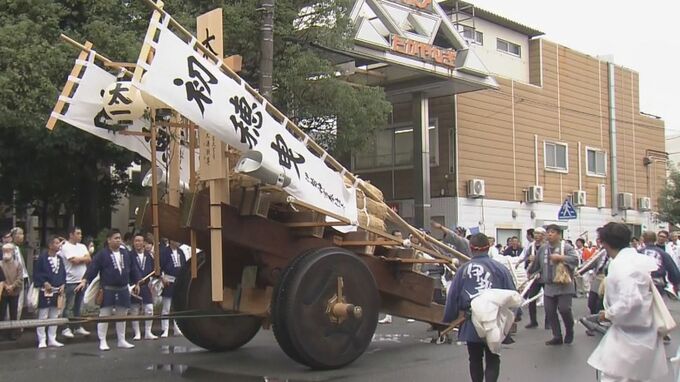The “Hatsuho-biki” ceremony celebrates the Kanname-sai festival by offering new rice and other produce to Ise Jingu Shrine in Mie Prefecture.
This event takes place every year on October 15th and 16th, marking its 54th occurrence this year.
Despite the unfortunate weather today, approximately 1,600 people energetically pulled two offering carts loaded with rice bales to the Geku (Outer Shrine) while shouting lively chants.
(Participant)
“It’s really enjoyable. The vibrant atmosphere gives me so much energy.”
“I was told ‘After rain comes fair weather,’ so I spent the time with a pleasant feeling.”
Tomorrow on the 16th, the “Kawa-biki” ceremony will be held to offer the first harvest to the Naiku (Inner Shrine).
Hatsuho-biki ceremony
The Hatsuho-biki ceremony is a traditional Shinto ritual held at Izumo Taisha Grand Shrine in Japan, marking the official start of the construction of a new shrine or the rebuilding of an existing one. During the ceremony, participants pull a sacred log (the “first timber”) with ropes to purify the wood and sanctify the building process. This ancient practice symbolizes the transfer of the deity’s spirit and ensures the spiritual purity of the new sacred structure.
Kanname-sai festival
The Kanname-sai is a major annual harvest festival held at the Ise Jingu, Japan’s most sacred Shinto shrine. During this ritual, which takes place in October, the first harvest of rice is ceremonially offered to Amaterasu-Ōmikami, the Sun Goddess, to express gratitude and pray for a bountiful year. It is a central and ancient rite that reaffirms the deep connection between the Imperial Family, the shrine, and Japan’s agricultural traditions.
Mie Prefecture
Mie Prefecture is a central Japanese region historically known as the seat of power for the Ise Grand Shrine, one of Shinto’s most sacred sites. The area also boasts a rich samurai heritage as the home of the Iga ninja and the Wedded Rocks of Futami, a natural Shinto site. Today, it remains a major spiritual destination and is famous for its cultured pearls from Ise Bay.
Geku (Outer Shrine)
The Geku, or Outer Shrine, is one of the two main shrines at Ise Jingu, the most sacred Shinto site in Japan. It is dedicated to Toyouke Omikami, the deity of food, housing, and clothing. According to tradition, it was established in the 5th century to provide food offerings to the deity of the Inner Shrine, Naiku.
Kawa-biki ceremony
The Kawa-biki ceremony is a traditional Japanese ritual marking the start of construction on a new building. During the ceremony, a symbolic log is pulled through the streets by participants to purify the land and pray for the safety and success of the project. This ancient Shinto practice connects modern construction with Japan’s cultural and spiritual heritage.
Naiku (Inner Shrine)
Naiku, or the Inner Shrine, is the principal and most sacred shrine at Ise Jingu in Japan, dedicated to Amaterasu Omikami, the sun goddess and mythical ancestor of the Imperial family. It is believed to have been founded over 2,000 years ago. In a unique tradition, the shrine’s main buildings are ritually rebuilt every 20 years in a ceremony known as Shikinen Sengu, preserving ancient architectural techniques and symbolizing renewal.






